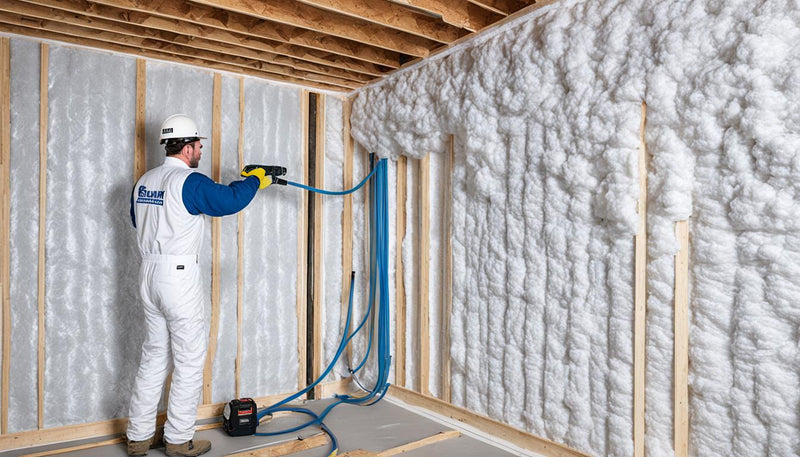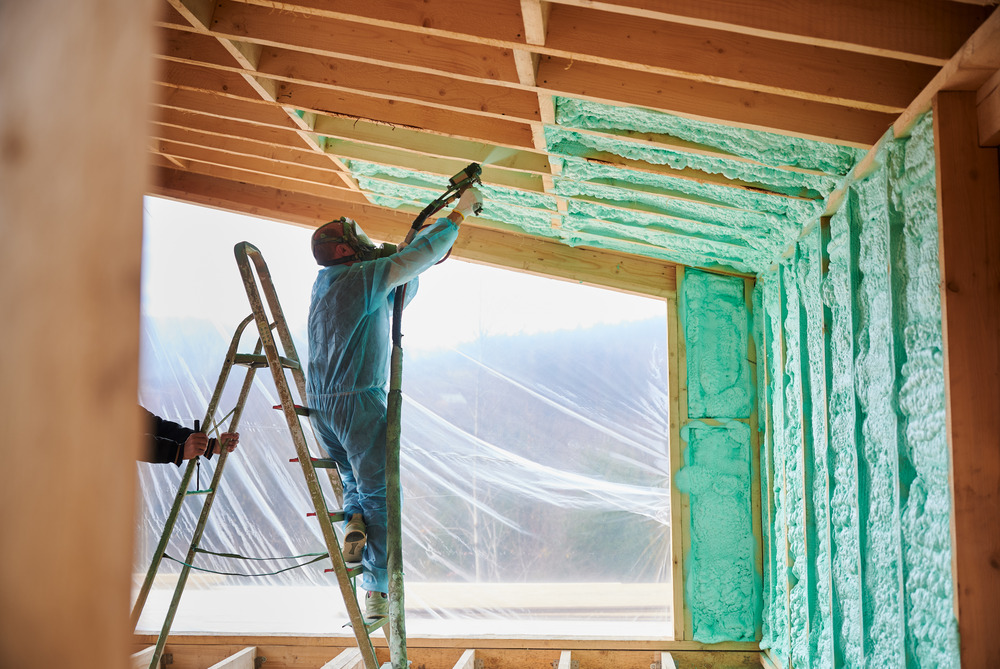Spray Foam: The Ultimate Solution for Air Sealing and Insulation
Spray foam insulation has arised as a leading option for reliable air securing and thermal insulation, offering a distinct mix of buildings that establish it besides conventional approaches. Its ability to expand and fill voids makes it particularly reliable in avoiding air leakage, which can substantially affect energy efficiency. However, recognizing the complete range of its benefits, installation procedures, and contrasts with other insulation types is essential for making notified decisions. As we check out these facets, the effects for both new constructions and retrofits end up being progressively significant. What variables should influence your choice?
What Is Spray Foam?
Spray foam is a flexible insulation material that integrates the principles of air securing and thermal resistance to enhance power efficiency in structures. Composed mostly of polyurethane or various other similar substances, spray foam is used as a liquid that expands upon contact with surfaces, producing a strong, continuous layer of insulation. This one-of-a-kind residential property allows it to fill spaces, cracks, and gaps that typical insulation materials may overlook, supplying an exceptional air seal.
There are 2 major types of spray foam: open-cell and closed-cell. Open-cell spray foam is lighter and much more versatile, using outstanding noise absorption and a reduced R-value per inch - Spray Foam. In contrast, closed-cell spray foam is denser, offering a higher R-value, wetness resistance, and included structural stability to constructing parts
The application procedure normally entails specialized equipment, guaranteeing a seamless application that complies with different substrates, consisting of wood, metal, and concrete. This flexibility makes spray foam appropriate for both brand-new constructions and retrofitting existing structures. Its ability to produce an impermeable barrier significantly adds to reducing energy consumption and improving indoor air high quality, consequently making it a favored option amongst home owners and contractors alike.
Benefits of Spray Foam Insulation
Among one of the most significant benefits of spray foam insulation is its exceptional capacity to create a continual air barrier, which effectively minimizes power loss. Unlike typical insulation materials, spray foam expands to load voids and cracks, making certain that air leak is drastically decreased. This characteristic not just boosts power efficiency but likewise causes decrease utility expenses in time.
Additionally, spray foam insulation supplies premium thermal resistance, adding to a much more stable indoor atmosphere. Its high R-value per inch enables reliable insulation in confined areas, making it optimal for attic rooms, wall surfaces, and crawl areas. The moisture-resistant residential or commercial properties of spray foam help avoid mold and mildew and mold development, promoting healthier living problems.
Another important advantage of spray foam insulation is its sound-dampening high qualities (Spray Foam). It successfully lowers sound transmission between spaces, producing a quieter and extra comfy home environment. The durability of spray foam additionally sticks out, as it does not droop or resolve over time, maintaining its performance throughout its life expectancy
How Spray Foam Works
Comprehending just how spray foam insulation functions is essential for appreciating its efficiency in air sealing and thermal resistance. Spray foam insulation consists of 2 key parts: isocyanate and polyol resin. When these parts are mixed, they undergo a chain reaction that causes the product to expand rapidly, creating a thick foam that fills fractures, tooth cavities, and gaps.
As the foam increases, it abides by surfaces, creating a closed seal that significantly reduces air infiltration. This characteristic makes spray foam insulation very reliable at preventing drafts and dampness infiltration, which can cause power loss and damages in time. In addition, the closed-cell variation of spray foam offers superior thermal resistance due to its inflexible structure, successfully reducing heat transfer.
The special homes of spray foam allow it to satisfy irregular surfaces, ensuring detailed coverage and a smooth barrier. Consequently, spray foam insulation not just enhances energy effectiveness yet additionally contributes to enhanced interior air high quality by reducing the accumulation of irritants and toxins. Ultimately, recognizing the mechanics behind spray foam emphasizes its function as an exceptional option for insulation and air securing in both commercial and domestic applications.
Setup Process Overview

Before installment, the room needs to be properly cleaned up and prepped, making sure that surface areas are click here for more info without debris, dirt, and wetness. Because contaminants can compromise attachment and general efficiency, this step is important. When the area is prepared, the application involves blending both elements of the spray foam, which broadens upon get in touch with and fills up spaces efficiently.
Trained specialists need to conduct the installation, utilizing customized devices to guarantee uniform coverage and optimal thickness. Security safety measures, including putting on safety gear and guaranteeing proper ventilation, are vital during this procedure. After application, the foam click commonly remedies quickly, creating a strong barrier that boosts energy efficiency.
Contrasting Spray Foam to Traditional Insulation
When examining insulation options, spray foam insulation stands out in comparison to typical products such as fiberglass and cellulose. Unlike fiberglass and cellulose, which can permit air infiltration, spray foam increases upon application, loading gaps and voids to create a closed seal.
Furthermore, spray foam offers a greater R-value per inch than typical insulation types, offering even more reliable thermal resistance in a thinner profile. This characteristic is especially helpful precede with limited cavity depth. Additionally, spray foam is resistant to moisture and mold and mildew development, which can be a considerable worry about cellulose and fiberglass, especially in moist settings.
Nonetheless, spray foam insulation generally brings a higher upfront cost than its standard equivalents. House owners must consider this preliminary financial investment against long-term power cost savings and performance benefits. Inevitably, while both insulation types offer their function, spray foam becomes a much more sophisticated service for modern insulation needs, particularly in regards to air securing and thermal effectiveness.

Verdict
In summary, spray foam insulation stands for a very effective service for accomplishing optimum air securing and thermal resistance. Its distinct residential or commercial properties, consisting of dampness resistance and audio dampening, make it appropriate for numerous applications in both brand-new constructions and retrofitting projects (Spray Foam). The initial costs might be greater contrasted to standard insulation materials, the long-term benefits, such as significant power financial savings and boosted interior air quality, warrant the investment and emphasize its worth in contemporary building practices.
Spray foam insulation has actually arised as a leading service for effective air sealing and thermal insulation, supplying an unique mix of residential properties that set it apart from conventional approaches.Spray foam is a functional insulation material that combines the concepts of air sealing and thermal resistance to enhance power effectiveness in structures.When evaluating insulation options, spray foam insulation stands out in contrast to standard materials such as fiberglass and cellulose. Inevitably, while both insulation kinds serve their function, spray foam emerges as an extra More hints sophisticated option for contemporary insulation needs, particularly in terms of air securing and thermal effectiveness.
In summary, spray foam insulation stands for an extremely effective service for accomplishing optimal air securing and thermal resistance.